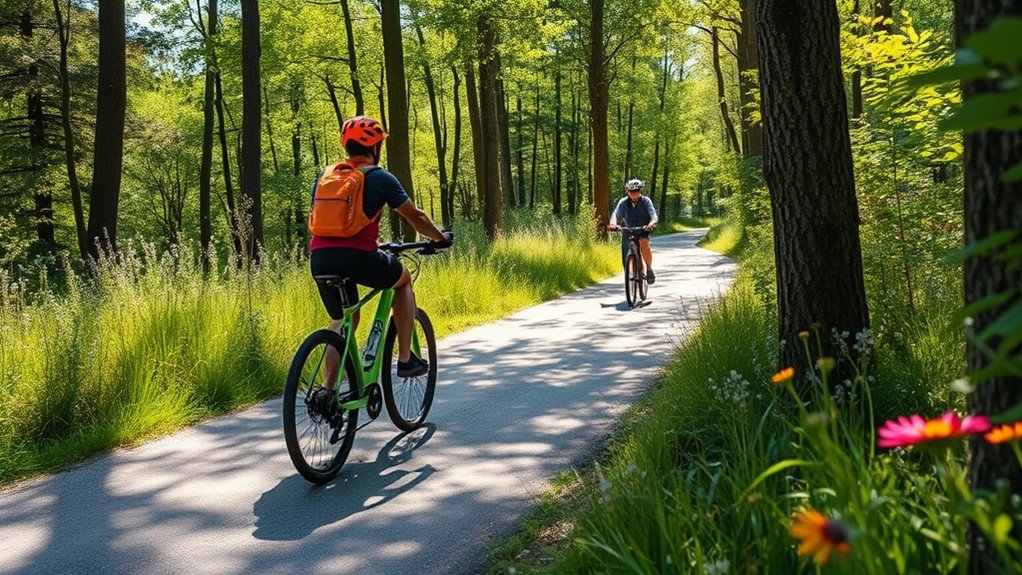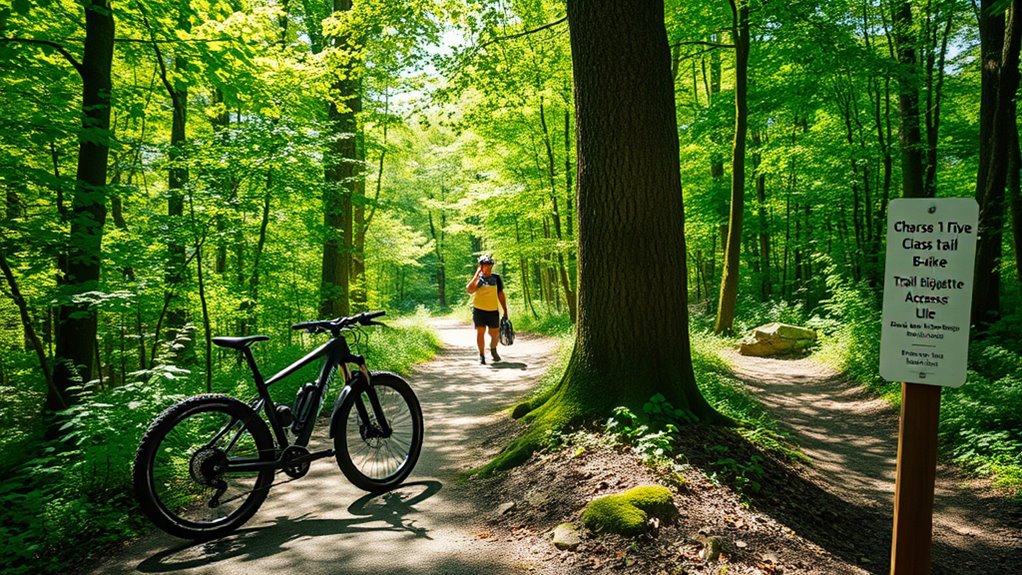To enjoy trail riding responsibly in 2025, you should follow proper etiquette by respecting signage, controlling your speed, and yielding to other users like hikers and horses. Always check local rules and trail access, and avoid trails where e-bikes aren’t permitted. Staying aware of your surroundings and maintaining trail integrity helps protect the environment and ensures everyone has a safe experience. Keep exploring to fully understand how to ride courteously and preserve these trails for all.
Key Takeaways
- Always follow trail signage and local regulations to ensure legal and safe access for Class 1 e-bikes.
- Control your speed, especially around blind corners and narrow sections, to prevent accidents and trail damage.
- Respect other trail users by yielding to hikers and horses, and announcing your presence on shared paths.
- Maintain minimal noise and report trail hazards to preserve a respectful environment for all.
- Ride responsibly and ethically to protect trail access, the environment, and ensure sustainable use for future riders.

As e-bike popularity grows, understanding proper trail etiquette becomes essential for Class 1 e-bike riders. You need to recognize that riding responsibly isn’t just about your enjoyment but also about respecting the environment and fellow trail users. Your rider responsibility includes being aware of trail signage, which provides vital information on trail conditions, user restrictions, and direction. Ignoring these signs can lead to accidents, trail damage, or conflicts with hikers and mountain bikers. Always approach trail signage with attentiveness, and follow the instructions carefully to confirm safe and respectful riding.
Your rider responsibility extends beyond just observing signs; it involves controlling your e-bike to maintain a safe speed and minimize impact on the trail. Since Class 1 e-bikes are limited to 20 mph, you should keep your speed in check, especially around blind corners, narrow sections, or crowded areas. This not only prevents accidents but also respects the trail experience for others. Be vigilant about your surroundings, and be prepared to slow down or stop if necessary. Remember, the trail isn’t just for you; it’s a shared space where everyone’s safety and enjoyment matter.
Proper trail etiquette also means respecting trail access regulations. Many parks and recreation areas specify which trails are open to Class 1 e-bikes. Before heading out, check local rules and trail maps to confirm you’re riding where you’re allowed. If a trail is marked as “no e-bikes,” respect that restriction, as ignoring it can lead to access issues for everyone and potential legal consequences. When in doubt, reach out to park authorities or look for posted notices to verify your riding permissions.
Additionally, you should be considerate of other trail users. Yield to hikers and horses, and give way to mountain bikers coming from behind when possible. Announce your presence when approaching others, especially on narrow paths, to prevent startling them. Keep your e-bike’s noise level minimal to avoid disrupting wildlife and fellow riders. If you encounter trail damage or hazards, report them to park officials instead of trying to bypass or repair on your own, maintaining the trail’s integrity for future use. Maintaining proper trail etiquette is essential for ensuring sustainable access and protecting the environment.
Ultimately, your rider responsibility is to ride with respect, awareness, and compliance with signage and regulations. By doing so, you help preserve trail access, protect the environment, and foster a positive experience for everyone sharing the trail. Proper etiquette isn’t just a set of rules; it’s a way to ensure that e-bike riding remains a sustainable and enjoyable activity for years to come.
Frequently Asked Questions
Are Class 1 E-Bikes Allowed on All Trail Types?
Yes, you can generally ride Class 1 e-bikes on most trail types, but always check trail signage first. Trail surface matters because some surfaces like dirt or gravel are more suitable for e-bikes, while others may be restricted. Always follow posted signs and regulations, as access can vary depending on trail policies. By respecting trail signage and surface conditions, you help ensure everyone’s safety and preserve trail integrity.
What Gear Restrictions Apply to Class 1 E-Bikes?
You can ride Class 1 e-bikes with no gear restrictions, as long as they meet the motorized restrictions of pedal-assist only up to 20 mph. Motorized restrictions limit power, ensuring e-bikes stay within non-motorized trail rules. Gear regulations are flexible, but it’s vital to stay within speed limits and trail access rules. Nearly 85% of trail managers allow Class 1 e-bikes, making understanding these restrictions essential for a smooth ride.
How Do Local Laws Vary for E-Bike Access?
You’ll find that state regulations for e-bike access vary widely; some states allow Class 1 e-bikes on all trails, while others restrict them to specific areas. Always pay attention to trail signage, which indicates whether e-bikes are permitted. Check local laws before riding, as enforcement and rules differ from place to place, ensuring you stay compliant and respect trail access restrictions.
Can I Ride a Class 1 E-Bike on Mountain Bike Trails?
You can ride your Class 1 e-bike on mountain bike trails if they’re designated for motorized access. Imagine gliding smoothly over well-maintained trails, where trail signage clearly marks permissible areas. Your presence helps fund trail maintenance, keeping paths safe and enjoyable. Always check local regulations and respect trail signage to avoid damage and conflicts. By following these rules, you help preserve the trails for everyone to enjoy.
Are There Age Restrictions for Riding Class 1 E-Bikes?
Age restrictions for riding Class 1 e-bikes vary by location, so you should verify local laws. Generally, riders need to be at least 14 or 16 years old, and some areas may require rider licensing or safety training. Always make certain you meet the age requirements and have any necessary licensing before hitting the trails. Staying compliant helps keep trails safe and accessible for everyone.
Conclusion
Just like a river flowing smoothly through the landscape, your respect for trail etiquette guides everyone safely along the path. When you ride responsibly, you become part of the current that sustains the trail’s harmony. Remember, every pedal stroke is a note in the symphony of shared adventure. Keep the flow respectful and steady, and the trail will continue to welcome you, weaving your journey into the greater story of nature’s rhythm. Ride mindful, and the trail will always return the favor.









